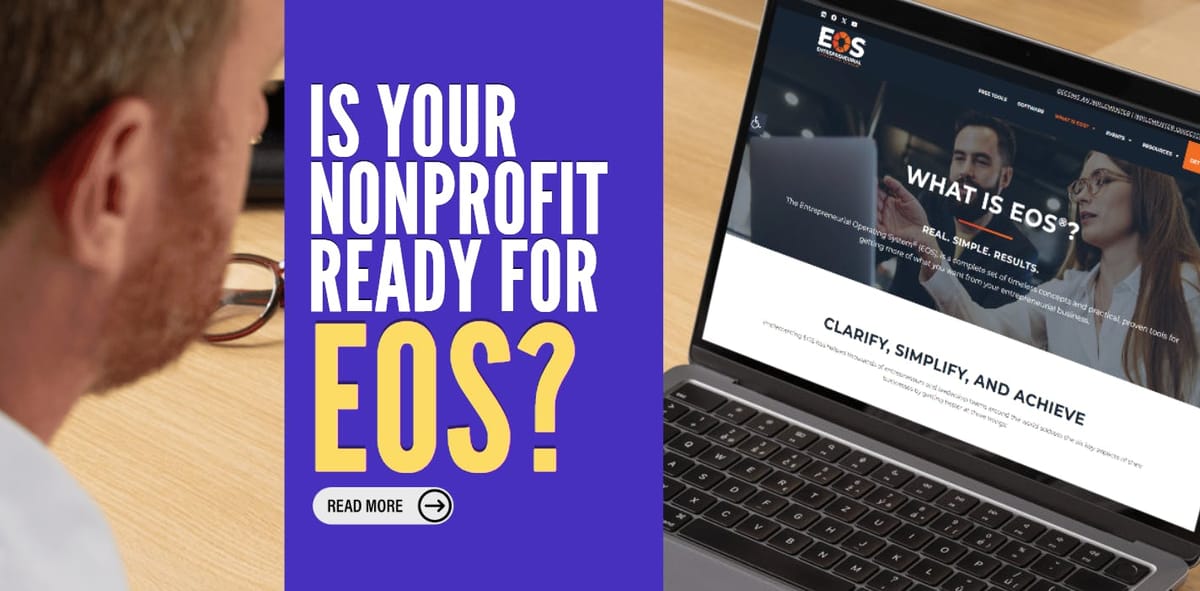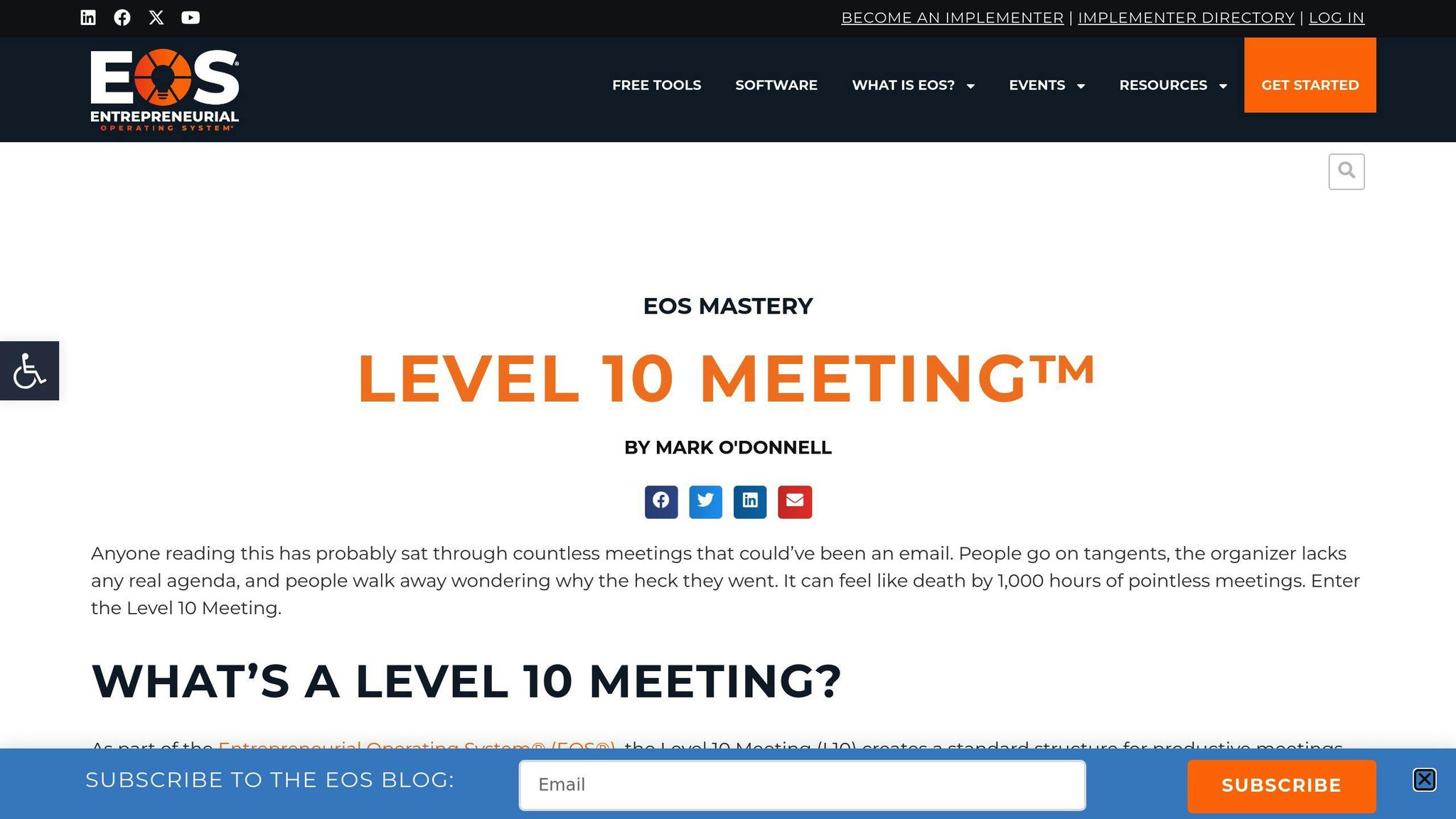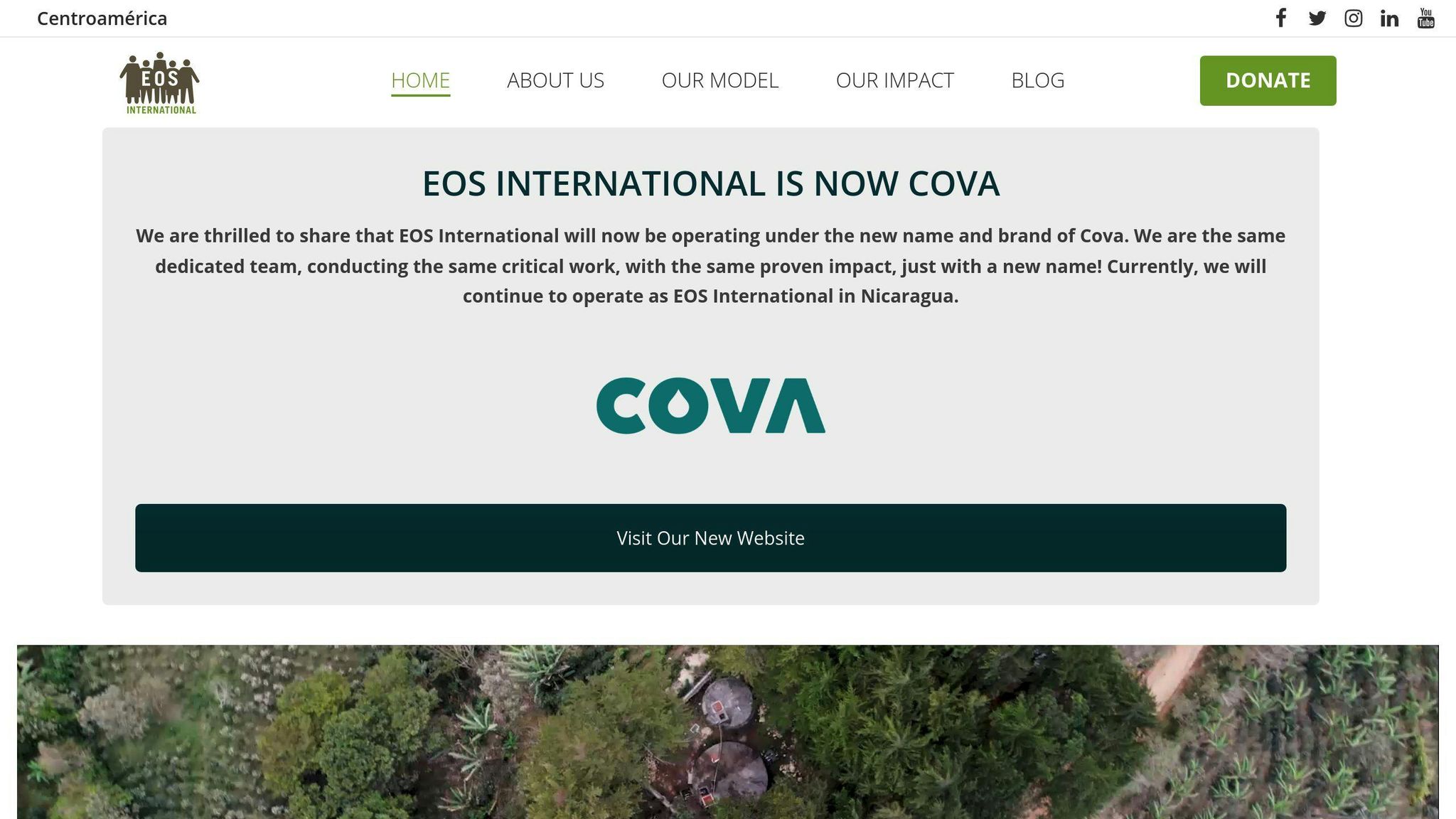The Ultimate Starter Guide to EOS for Nonprofits: Boost Your Impact and Streamline Operations
Discover how EOS can transform your nonprofit, aligning your team and boosting impact while streamlining operations for greater success.

EOS can help nonprofits boost impact and streamline operations. Here's what you need to know:
- EOS adapts business tools for nonprofit use
- Focuses on 6 key areas: Vision, People, Data, Issues, Process, Traction
- Helps align teams, improve meetings, and solve problems faster
- Requires commitment and willingness to change
Key Features
- Vision/Traction Organizer (V/TO): 2-page roadmap for your organization
- Level 10 Meetings: Weekly 90-minute sessions to stay on track
- IDS (Identify, Discuss, Solve): Simple problem-solving method
To get started with EOS:
- Assess your nonprofit's readiness
- Choose between self-implementation or hiring a Pro EOS Implementer
- Begin with a 90-Minute Meeting to learn EOS basics
- Hold a Focus Day to set up initial structures
- Use Vision Building Days to clarify long-term goals
- Implement the Six Key Components across your organization
EOS can help manage volunteers, improve board relationships, and boost child sponsorship programs. Real-world examples show increased efficiency and impact for various nonprofits.
Quick Comparison:
| EOS Component | Business Focus | Nonprofit Application |
|---|---|---|
| Vision | Market share | Community impact |
| People | Employees | Staff and volunteers |
| Data | Sales figures | People served |
| Issues | Competitors | Funding challenges |
| Process | Efficiency | Mission delivery |
| Traction | Quarterly goals | Program milestones |
While EOS isn't a magic solution, it provides a framework for nonprofits to align their efforts with their mission and achieve greater impact.
Related video from YouTube
What is EOS for nonprofits?

EOS (Entrepreneurial Operating System) isn't just for businesses. Nonprofits can use it too. It's a set of tools to help you run smoother and hit your goals.
6 key parts of EOS
- Vision: Get everyone on the same page
- People: Right people, right roles
- Data: Use numbers, not just gut feelings
- Issues: Spot and fix problems fast
- Process: Write down how you do things
- Traction: Do what you say you'll do
Making EOS work for nonprofits
Tweak EOS to fit your nonprofit:
- Vision: Use the V/TO™ to spell out your mission
- People: Match strengths to roles
- Data: Track mission-related numbers (people helped, donations)
- Issues: Use Level 10 Meetings™ to solve problems
- Process: Document key tasks (volunteer onboarding, event planning)
- Traction: Set 90-day "Rocks" to stay focused
"When everything is important, nothing is important." - Gino Wickman, Author of Traction
EOS helps nonprofits:
- Align everyone's efforts
- Make meetings count
- Solve problems early
- Focus on what matters
Is your nonprofit ready for EOS?
Let's see if EOS fits your nonprofit.
Take a hard look at your organization. Do you:
- Have big goals but struggle to achieve them?
- Work hard without seeing results?
- Have a clear vision but no roadmap?
- Find it tough to align your team?
If you're nodding, EOS might be your answer.
Quick checklist:
| EOS Readiness Checklist | Yes/No |
|---|---|
| Clear long-term strategy | |
| Defined short-term goals | |
| Effective meetings | |
| Strong financial management | |
| Low staff turnover | |
| Regular communication |
More "No" answers? You might need EOS.
For EOS to work, your leaders must be:
- Open to change
- Honest about problems
- Willing to be vulnerable
"We needed a rallying cry." - Amy Action, CEO of Phoenix Society for Burn Survivors
The Phoenix Society used EOS to reach their "One Million Strong" goal. They cut frustration and improved operations.
EOS isn't just for businesses. Nonprofits can use it too. But it's not a quick fix. It takes work and commitment. You'll need to adapt it to your nonprofit's needs.
Ready to boost your impact? EOS might be your tool. Just make sure your team's on board.
How to start using EOS
Let's dive into bringing EOS into your nonprofit.
Steps to follow
- Check your readiness
Is your team open to change? You need buy-in from leadership.
- Pick your path
Self-implement or hire a Pro EOS Implementer. DIY is cheaper but tougher.
- Kick off with a 90-Minute Meeting
Get the EOS basics and see if it fits your nonprofit.
- Hold a Focus Day
Create your Accountability Chart, set 90-day Rocks, and establish a Meeting Pulse.
- Craft your vision
Use Vision Building Days to nail down Core Values, Core Focus, and long-term goals.
- Roll out the Six Key Components
| Component | Action |
|---|---|
| Vision | Set clear goals |
| People | Right folks, right roles |
| Data | Track key metrics |
| Issues | Solve problems |
| Process | Standardize procedures |
| Traction | Turn vision into action |
- Spread EOS company-wide
Don't keep it at the top. Get everyone involved.
- Regular check-ins
Set up quarterly meetings and yearly planning sessions.
Tackling problems
- Change resistance: Be patient. It takes time to sink in.
- Weak accountability: Use the EOS People Analyzer to check role fit.
- Spotty implementation: Aim high, but celebrate progress.
- EOS confusion: Have clear explanations ready for questions.
- Mission vs. metrics: Keep your purpose front and center.
EOS isn't a magic wand. It's hard work. But stick with it, and you'll boost your nonprofit's impact.
"EOS Powered by Ninety was a great choice...it got our team pulling together...and helped us focus on working on the business, not just in it." - Jeff Harsh, President of Concept.
Keeping your mission in mind
EOS can supercharge your nonprofit, but you've got to stay laser-focused on your goals. Here's how to make it work without losing your way.
Staying true to your purpose
EOS isn't about changing your mission. It's about turbocharging it. Use the Vision/Traction Organizer (V/TO) to spell out your nonprofit's purpose. It's like a roadmap for everyone.
Take a food bank, for example. Their V/TO might shout "Ending hunger in our community". Then, they'd line up their EOS goals with this big idea. Think tracking meals served or families helped.
As you dive into EOS, keep asking: "Does this move us closer to our purpose?"
Tweaking EOS for nonprofits
EOS was built for businesses, but you can remix it for nonprofits. Here's how:
1. Metrics makeover: Forget profit. Focus on impact. Count volunteer hours, people helped, or funds raised.
2. Rethink "customer": In your world, this could mean donors, volunteers, or the folks you're helping.
3. Meeting remix: Level 10 Meetings can work, but you might need to carve out time for mission talk.
4. Accountability Chart 2.0: Add nonprofit-specific roles like "Volunteer Coordinator" or "Grant Writer".
Check out this quick comparison:
| EOS Component | Business Focus | Nonprofit Twist |
|---|---|---|
| Vision | Market share | Community impact |
| People | Employees | Staff and volunteers |
| Data | Sales figures | People served |
| Issues | Competitors | Funding challenges |
| Process | Efficiency | Mission delivery |
| Traction | Quarterly goals | Program milestones |
By tweaking EOS, you can amp up your impact while staying true to your mission.
"When your non-profit, church or private school runs on EOS, everyone is rowing in the same direction." - GPS for Small Business
This nails it. EOS can align your team, but make sure you're all paddling towards YOUR unique goals.
EOS tools for better nonprofit work
Let's look at three EOS tools that can boost your nonprofit's operations:
Vision/Traction Organizer

The Vision/Traction Organizer (V/TO) is a two-page roadmap for your nonprofit. It's like a GPS for your organization.
Here's what it covers:
| Component | Description |
|---|---|
| Core Values | Your guiding principles |
| Core Focus | Your purpose and niche |
| 10-Year Target | Your big, long-term goal |
| 3-Year Picture | Success in 3 years |
| 1-Year Plan | Top priorities for next year |
| Quarterly Rocks | Key goals for next 90 days |
To create your V/TO:
- Hold a two-day offsite meeting with your leadership team
- Work through each component
- Document your decisions clearly
- Share with your entire organization
"Creating a vision for the business is critical to maintaining a path to success." - Gino Wickman, EOS Worldwide Founder
Level 10 Meetings

These are weekly, 90-minute sessions to keep your team on track. The agenda:
| Time | Item |
|---|---|
| 5 min | Check-in |
| 5 min | Scorecard review |
| 5 min | Rock review |
| 5 min | Customer/employee headlines |
| 5 min | To-do list review |
| 60 min | IDS (Identify, Discuss, Solve) |
| 5 min | Conclude and recap |
The IDS section is where you tackle your top three issues.
Tips for effective Level 10 Meetings:
- Same time every week
- Stick to the agenda
- Come prepared
IDS: Identify, Discuss, Solve

IDS is a simple way to tackle problems:
- Identify: What's the real issue?
- Discuss: Share all relevant info
- Solve: Agree on a solution and next steps
Example: Your nonprofit's volunteer turnover is up 30%.
- Identify: High volunteer turnover
- Discuss: Team shares feedback on scheduling, training gaps
- Solve: Create new volunteer onboarding program
These tools can help streamline your nonprofit's operations and keep everyone focused on your mission.
Tracking success with EOS
EOS isn't just about setting goals. It's about measuring progress. Here's how nonprofits can track their success using EOS methods:
Choosing what to measure
Picking the right metrics is key. Here's how:
- Start with your V/TO: Use your Vision/Traction Organizer as your roadmap. It'll help you spot key areas to measure.
-
Focus on leading indicators: These predict future performance. For nonprofits, think:
- New donor numbers
- Volunteer retention rates
- Program participation rates
- Keep it simple: Don't measure everything. Stick to 5-15 key metrics.
- Align with your mission: Every metric should tie back to your nonprofit's purpose.
Checking your progress
Once you've picked your metrics, it's time to track them:
- Create a Scorecard: This EOS tool gives you a weekly snapshot of your nonprofit's health. Here's an example:
| Metric | Goal | Week 1 | Week 2 | Week 3 | Week 4 |
|---|---|---|---|---|---|
| New donors | 20 | 18 | 22 | 19 | 25 |
| Volunteer hours | 500 | 480 | 510 | 495 | 520 |
| Program participants | 100 | 95 | 102 | 98 | 105 |
- Review weekly: Spend 5 minutes on your Scorecard in Level 10 Meetings. It keeps everyone on the same page.
- Set Rocks: These are your 90-day priorities. Make them SMART and tie them to your Scorecard metrics. For example:
"Boost volunteer retention from 60% to 75% by launching a new onboarding program in 90 days."
- Use IDS: When metrics go off track, use Identify, Discuss, Solve to fix issues fast.
Fixing common nonprofit issues with EOS
Nonprofits face unique challenges. EOS can help. Let's look at two big issues:
Managing volunteers better
Volunteers are crucial for nonprofits. But managing them? Not easy. Here's how EOS helps:
1. Clear roles
Use the Accountability Chart. Everyone knows what to do.
2. Better onboarding
Create a process with EOS tools. Include orientation, training, and mentorship.
3. Regular check-ins
Use Level 10 Meetings with volunteer teams. Keep everyone aligned.
Add volunteer metrics to your Scorecard:
| Metric | Goal | Week 1 | Week 2 | Week 3 | Week 4 |
|---|---|---|---|---|---|
| Volunteer hours | 500 | 480 | 510 | 495 | 520 |
| Retention rate | 80% | 75% | 78% | 82% | 80% |
| New volunteers | 10 | 8 | 12 | 9 | 11 |
5. Solve issues fast
Use IDS to address volunteer concerns quickly.
Improving board management
Boards can make or break a nonprofit. EOS smooths out board relationships:
1. Align on vision
Use the V/TO. Get everyone on the same page. Review quarterly.
2. Structured meetings
Apply Level 10 Meeting format to board meetings. Keep discussions focused.
3. Clear communication
Create a "Board Update" in your EOS rhythm. Share key metrics and progress.
4. Solve problems together
Use IDS in board meetings for big issues.
5. Avoid "organizational whiplash"
EOS Worldwide found this common in nonprofits. To fix it:
- Center decisions on the V/TO
- Hold regular alignment meetings
- Create a structured board meeting agenda
EOS for child sponsorship programs
Child sponsorship programs can be tricky. EOS can help. Here's how:
Simplify sponsorship management
EOS tools make things easier:
- Accountability Chart: Define roles clearly. Everyone knows what to do.
- Level 10 Meetings: Weekly meetings to tackle issues. Here's the format:
| Time | Agenda Item |
|---|---|
| 5 min | Check-in |
| 5 min | Scorecard review |
| 5 min | Rock review |
| 5 min | Customer/employee headlines |
| 60 min | IDS (Identify, Discuss, Solve) |
| 5 min | Conclude |
- Scorecard: Track key metrics weekly:
| Metric | Goal | Week 1 | Week 2 | Week 3 | Week 4 |
|---|---|---|---|---|---|
| New sponsors | 50 | 45 | 52 | 48 | 55 |
| Sponsor retention rate | 90% | 88% | 91% | 89% | 92% |
| Update letters sent | 500 | 480 | 510 | 495 | 520 |
- Vision/Traction Organizer (V/TO): Get everyone on the same page about goals and strategies.
Boost donor relationships
EOS can help you connect better with donors:
- Automate communication: Set up systems for welcome emails, updates, and reminders.
- Moderate messaging: Create a safe process for sponsor-child communication.
- Track engagement: Add these to your Scorecard:
| Metric | Goal | Week 1 | Week 2 | Week 3 | Week 4 |
|---|---|---|---|---|---|
| Donor emails opened | 70% | 68% | 71% | 69% | 72% |
| Donor event attendance | 100 | 95 | 105 | 98 | 102 |
| Feedback surveys completed | 50 | 48 | 52 | 49 | 51 |
- Use IDS for issues: Solve donor problems fast with Identify, Discuss, Solve.
-
Create a donor portal: Give sponsors a place to:
- See their child's profile
- Send messages
- Donate
- Get updates
EOS isn't just for businesses. It can transform your child sponsorship program, making it more efficient and impactful.
Real examples of EOS in nonprofits
EOS has made waves in the nonprofit world. Let's dive into some success stories:
Argentina's Entrepreneurial Nonprofit
An old Argentine nonprofit saw a big boost after adopting EOS. They:
- Set clearer goals
- Improved teamwork
- Streamlined operations
The result? They helped more people and made a bigger splash in their community.
The LID Group's AI Push
The LID Group, with Molito.ai and CloudShore, used EOS to level up. They focused on:
- AI solutions
- Network growth
- Job creation in new markets
EOS helped them make big strides in automation and employment.
EOS International's Water Mission

EOS International (now Cova) brings clean water to Central America. With EOS, they:
- Set clear targets
- Tracked progress
- Solved problems faster
This approach helped them reach more rural families with safe water and income opportunities.
South African Children's Organization
A South African nonprofit used EOS to up their game. They found:
- Clearer roles
- More productive meetings
- Better decision-making
The upshot? More focus on helping kids, less on running the org.
Here's a quick comparison:
| Nonprofit | Before EOS | After EOS |
|---|---|---|
| Argentina Nonprofit | Fuzzy goals, inefficient | Clear direction, bigger impact |
| LID Group | Standard ops | AI innovation, job creation |
| EOS International | Basic outreach | Expanded clean water access |
| South African Org | Unfocused meetings | More time helping children |
These examples show EOS works for various nonprofits, helping them zero in on their mission and boost results.
Conclusion
EOS packs a punch for nonprofits. Here's what it brings:
- Clear direction
- Better teamwork
- Smoother operations
- Focused meetings
- Measurable progress
Let's break it down:
| EOS Component | Nonprofit Benefit |
|---|---|
| Vision | Aligns everyone with the mission |
| People | Right folks in the right roles |
| Data | Decisions backed by numbers |
| Issues | Problems solved systematically |
| Process | Consistent, efficient work |
| Traction | Goals turned into action |
Next steps
Ready to dive in? Here's how:
1. Learn more
Check out EOS resources for nonprofits.
2. Assess your org
Look at where you stand now.
3. Get buy-in
Talk to your team and board about EOS.
4. Start small
Pick one EOS tool to try, like the Level 10 Meeting.
5. Seek help
Consider working with an EOS Implementer.
EOS isn't a magic fix. It's a toolset that works when you commit to using it. As Gino Wickman, the EOS creator, says:
"At its core, EOS is all about aligning human energy."
So, align your team's energy with your mission. With EOS, you can make a bigger impact in your community.
FAQs
Can EOS work for nonprofits?
Yes, EOS can be a game-changer for nonprofits. Here's why:
EOS helps nonprofits stay laser-focused on their mission while turbocharging their operations. It's like giving your organization a superpower - you'll do more with what you've got and get everyone moving in the same direction.
"EOS lets nonprofits run like a well-oiled machine without losing their heart. They end up making a bigger splash in their communities", says Mark O'Donnell, an EOS pro.
Want to give EOS a spin? Start small:
- Take a hard look at where you're at
- Think about what you're really trying to achieve
- Figure out who your key players are
- Pick ONE EOS tool and try it out

